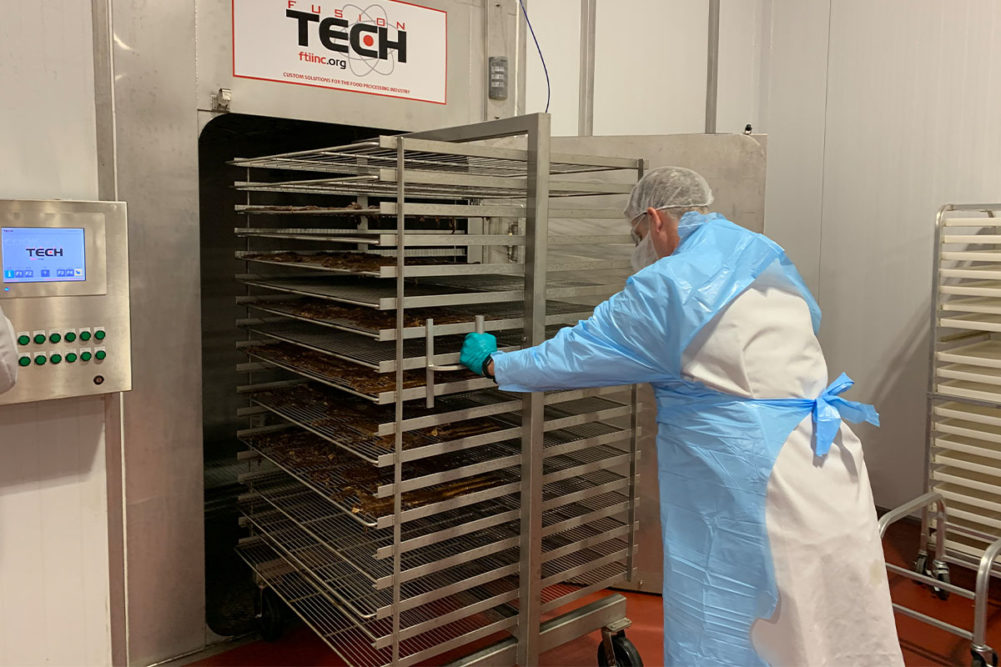This article was published in the September 2022 issue of Pet Food Processing. Read it and other articles from this issue in our September digital edition.
Efficiency is the end all be all in a modern pet food or treat manufacturing operation. Amid the multitude of industry challenges, being able to produce safe product consistently and reliably is the crux of any successful business.
The dehydration process, on the other hand, is no poster child for processing efficiency. This method “begets a long, drawn-out processing time,” with cook times that can exceed 10 hours, according to Jason Jordan, director of marination technology, staff food scientist, Fusion Tech, Roseville, Ill. So, why bother?
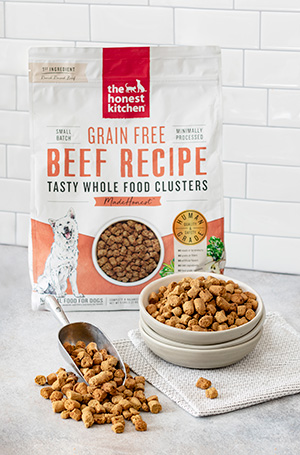 Product quality tops efficiency for The Honest Kitchen, which uses a dehydration process to achieve the best nutritional outcome for its dehydrated, human-grade pet food and treat products. (Source: The Honest Kitchen)
Product quality tops efficiency for The Honest Kitchen, which uses a dehydration process to achieve the best nutritional outcome for its dehydrated, human-grade pet food and treat products. (Source: The Honest Kitchen)
“Dehydration is not necessarily a fast, efficient production method,” said Lucy Postins, founder and chief integrity officer, The Honest Kitchen, San Diego, Calif. “It’s slow and gentle, so it takes time and care to dehydrate ingredients properly with the correct temperature to maintain as much of the natural nutrition as possible, while also ensuring that the risk of ingredient-specific pathogens is eliminated.”
For super-premium brands like The Honest Kitchen, processing efficiency is supplanted by product quality and brand positioning. The brand has been built on the promise that regardless of its success, The Honest Kitchen will stay true to its nutritional philosophy and the cooking methods that help achieve it.
“The key benefit of dehydration is that it’s a very gentle method of preparing food, and uses much lower temperatures compared with traditional methods such as canning and extrusion,” Postins added. “Lower temperatures mean that the ingredients are treated more gently, which in turn helps to preserve more of the natural nutrients.”
As pet food formats continue to evolve alongside consumer demand, brands are looking to suppliers to help them produce premium product in a way that is consistent, safe and economical.
“Processors are continually searching for equipment that delivers repeatability and consistency so they can minimize process variation,” said Marty Wimmer, product sales manager, batch thermal, Marlen, Riverside, Mo.
“It’s very important to understand the recipes and how everything ties together,” said Steve King of ALKAR-RapidPak, Inc.
To achieve this consistency and optimize efficiency in a dehydration process, pet food and treat manufacturers must be able to control and fine-tune three variables inside the oven: temperature, humidity and airflow.
Hitting the trifecta
The main goal of any dehydration process is to remove water from the product to create a shelf-stable, food-safe result.
“Ultimately what you’re looking for is a certain water activity that makes the product shelf-stable and safe,” said Steve King, vice president of global sales, ALKAR-RapidPak, Inc., a subsidiary of Middleby based in Lodi, Wis. “That magic number for water activity is 0.85; most people shoot for 0.8 for jerky. For kibble and cookies, you’re looking at anywhere between 0.4 and 0.55.”
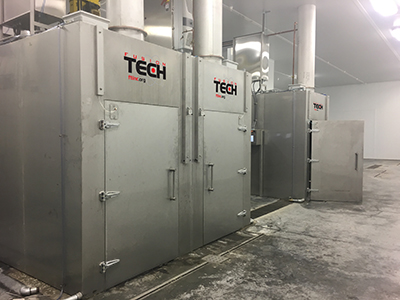 Fusion Tech’s smokehouse dehydrators are equipped with Total Flow Control (TFC), a feature that allows operators to manipulate airflow and other crucial attributes inside the oven and save recipe parameters for future use. (Source: Fusion Tech)
Fusion Tech’s smokehouse dehydrators are equipped with Total Flow Control (TFC), a feature that allows operators to manipulate airflow and other crucial attributes inside the oven and save recipe parameters for future use. (Source: Fusion Tech)
According to King, achieving a narrow range for variation of water activity — whether in a batch process or a continuous process — can help companies prevent complications down the road for shelf life and food safety, which may ultimately lead to a product recall.
“You have to figure out how much water you’re evaporating from the process, which requires a certain amount of energy,” King said. “No matter how you slice it, you have to look at how that water and moisture is removed and, subsequently, how it is put back into the air. Any evaporated water must get out of the system, and that has to be consistent.”
In an oven that uses microwave technology, such as ALKAR-RapidPak’s Turbochef system, it’s important to consider how evaporated water coming off a product will be removed from the oven. If it remains in the oven, King explained, microwave energy will continue seeking out moisture and the cycle is prolonged. Aside from understanding the precise amount of energy needed to remove water to a certain point, an exhaust system is needed to remove evaporated moisture from the air, he added.
For example, an exhaust system helps ALKAR-RapidPak’s customers vent evaporated moisture out of the machine. This, along with good airflow, ensures the evaporated water doesn’t continue to be a factor.
“The ideal state is where the surface of a product is at a temperature and moisture content that is just under the dew point,” Jordan explained. “At that point, we’re keeping everything hydrated, and we can most efficiently move water out of that product.”
To this end, temperature, humidity and airflow control must coexist and be adaptable to each formulation. A low-humidity environment can create a case-hardening effect on a pet food or treat product, in which the surface of the product is dried by heat while the interior still has a substantial amount of moisture, Jordan said.
“Now we have to wait for the exogenous moisture that’s still in the center of this product to rehydrate the surface and move out of the center of that product,” he explained. “Then, by default, we have to dehydrate that surface again, which prolongs total drying time.”
Most commonly, processors will introduce humidity to the cooking cycle in one of two ways: using a small nozzle to atomize water into the chamber, where water droplets are passed through heating coils, or by injecting a small amount of raw steam into the oven until the ideal humidity is achieved. This is not to be confused with a steam oven, where the heating source is raw steam injected directly into the oven house.
“Sometimes we’ll hit the product with steam to instigate the water,” King added. “The steam helps move the water and actually helps with drying. Steam in the first step of a two- or three-step process helps with the drying process.”
It may seem counterintuitive — adding moisture to help dry out a product — but for jerky treat applications, King attested to seeing more consistent color, less bubbling, a reliable kill step and log reduction in certain pathogens, and an overall better product when incorporating steam into the process.
How does airflow factor into this equation? According to Jordan, the origin of the oven in Europe relied on vertical airflow to cook hanging meats in a cooking apparatus. In today’s pet food and treat processes, product is crowded onto racks, which are then stacked as close together inside the oven as possible to maximize throughput.
“How do we get that air to dump its thermal load and product to pick up that thermal load? It’s all about the efficiency of moving that air across the surface of the product,” Jordan said. “That’s why airflow becomes a very, very important piece of this topic.”
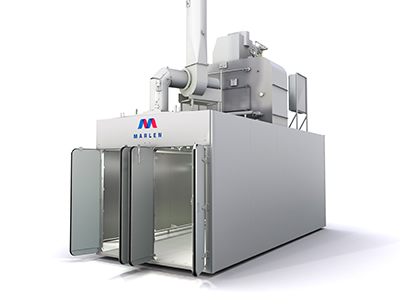 Marlen’s Industrial Dehydrators are balanced before delivery and installation, resulting in an up to 2% yield increase compared to unbalanced systems. (Source: Marlen)
Marlen’s Industrial Dehydrators are balanced before delivery and installation, resulting in an up to 2% yield increase compared to unbalanced systems. (Source: Marlen)
These densely populated and closely spaced layers make it difficult to move air through the product vertically, so processors must create what are called breakpoints inside the oven to create a horizontal airflow. By using a combination of low and high velocity airflow on opposite sides of the oven, the goal is to get those streams to collide and create a horizontal airflow through the use of different fan and duct configurations.
To help processors configure these breakpoints, Fusion Tech offers a Total Flow Control (TFC) feature for its ovens that allows operators to change and manipulate airflow inside the oven. It also controls the length of time for certain breakpoints or how long a product spends in a particular zone, all managed through a control panel and linked to a saved recipe. This not only helps to ensure consistency from product to product and batch to batch, but also maximizes the efficiency of the oven and the operator’s control of airflow.
Additionally, raw material inputs can have a direct impact on processing times. The pet food industry often uses mechanically deboned or separated animal-based proteins, according to Jordan, which tend to have higher fat-to-protein ratios than what are typically used in human food products. Because fat does not relinquish water as easily as protein, using a protein source that is higher in fat can slow down the dehydration process and result in a more time-consuming and costly operation.
“Sometimes, there is a play to be made on increasing input costs from a raw material standpoint that could substantially reduce cook times, therefore increasing efficiency,” Jordan said. “If we can take an 11-hour thermal processing cycle down to nine hours, all of a sudden that processor has doubled their efficiency, effectively getting two turns per day in their oven instead of one.”
Taking variation out of the equation
Achieving this perfect balance is no easy task. To this end, suppliers in this space are fine-tuning their systems to offer more reliable air circulation.
Marlen’s ovens, for example, are balanced prior to delivery and installation and remain permanently balanced, reducing the need for operators to continually check for proper airflow. The airflow in Marlen ovens is programmable, which allows operators to make small adjustments from product to product — and save those parameters for future runs — through the control panel.
“Permanent balance means that the airflow in the oven is always balanced to design specification,” Wimmer said. “Studies have proven a 1.5% to 2.0% yield increase in a balanced dehydrator/oven versus an unbalanced dehydrator/oven.”
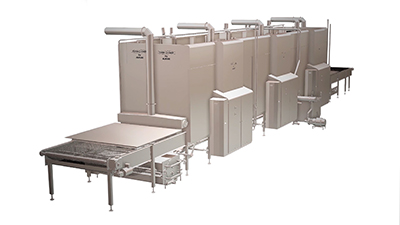 An exhaust system is necessary to remove evaporated water from the process, especially in a system that uses microwave energy. (Source: ALKAR-RapidPak, Inc.)
An exhaust system is necessary to remove evaporated water from the process, especially in a system that uses microwave energy. (Source: ALKAR-RapidPak, Inc.)
According to King, some companies will elect to run a batch process rather than a continuous process to guarantee consistency. In today’s tight labor market, running a batch process necessitates more people to unload, clean and reload the oven, creating more downtime for an already drawn-out process.
“It’s not just global demand that is pushing pet treat manufacturers toward automation,” Wimmer noted. “As labor shortages continue, automation becomes increasingly important. Marlen has options for automating dehydrators and offers a wide array of water and steam cooking options for the pet food and treat industry.”
For pet food and treat companies looking to enter the dehydrated category, King recommended operators and quality assurance teams meet first to discuss how to ensure the intended process meets product characteristics and food safety standards while being consistent and reliable.
“All this takes more time and expense compared with throwing everything into an extruder, but we wholeheartedly believe it’s worth it to make a superior product and we absolutely prioritize quality over cost,” Postins concluded.
Find more articles about the latest pet food processing technologies on our Equipment page.

